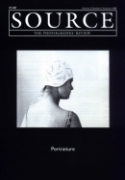Clive Landen
Familiar British Wildlife
Review by Martin McCabe
Issue 9 Autumn 1996
View Contents ▸
The relationship between death and representation have always been profoundly and intimately intertwined. Never more so than with the emergence of the photomechanical apparatus in the middle of the last century. So much so that some early photographic processes were called Thanatography derived from the Greek word Thanatos meaning 'death'. And some of the most startling images from that same period were images of the dead. They exemplified what Barthes would later go on to say about photography "it must be described in relation to death". This particular preoccupation has undergone a re-emergence in the last decade or so led by photographers like Witkin and more recently in Luc Sante's collection of forensic photography from the turn of the century amongst others.
However, Clive Landen's Familiar British Wildlife series deals not with human death but with 'roadkills'. His perspective seeks out a different angle and engages a specific purpose. The ostensible content of the collection of these images is the carcasses and remains of domestic wildlife lying by the side of the road. They are all photographed in the same formal manner using a tripod signifying a kind of forensic strategy at work. They are the physical evidence of the unfortunate conjunction of vehicle and animal (although some of them are so well laid out that they seem orchestrated). The forensic reading is reinforced by the titling of the images using the precise zoological nomenclature and the road reference number indicating the general location of the event. This textual information accompanying the image is reminiscent of an exhibit from the Natural History museum, whose institutional rhetoric insists at one and the same time on the beauty and diversity of 'nature' and on the desire to control and order the chaos of Nature. The ironic mimicking of the optics of instrumental reason by Landen attempts to force a consideration of the relationship between human endeavour and wildlife and by implication 'nature' and the environment. Mustela Erminea Stabilis A48
Mustela Erminea Stabilis A48
This throws up a number of interesting questions. As a collection of images it demonstrates the reliance of the visual sign on text to anchor meaning. Representation is foregrounded in this manner. For without the text some of the images could be read as 'trophies' or examples of fine specimens or in the case of the small birds as formal and abstract studies. It could be argued that Landen's ironic take on the taxonomic impulse of Western knowledge systems performs a type of meta-documentary text where the historical antecedents and indeed the genre itself is held up for examination and commentary. The point here being that the camera has historically been in the service of science in its efforts to produce the order of things. However the ecological critique implied here is less sophisticated. Modern technological living, it is suggested, has distanced us from Nature and we need to somehow become reconnected to 'it'. This is in the crudest sense naive and simplistic. But it is a disquieting aspect which is underlined in the publicity material produced for the show that claims the work "...considers death; not just the literal death of animals themselves but the metaphoric death of an aspect of our (sic) national identity - the cherished countryside of our imagination". The preface for the catalogue reiterates the same evocation of national identity citing Watership Down and Last of the Summer Wine as exemplars of some idyllic past. (It is important to note that it is British wildlife and the assumed audience of the catalogue is a British one). The deep and complex mythologisation of Britain as a green and pleasant land teeming with wildlife should not go unchallenged. Consider for instance, the mobilisation of this myth by reactionaries and neo-conservatives in Britain with all its connotations about 'race', ethnicity, and class. (The black artists Eve Pollard and Maud Sulter have addressed these mythologies in their own photographic practices). But it also highlights some subtle but identifiable cultural differences between for example Ireland or Europe and Britain's attitudes to 'nature'. Is it only in Britain that the media construct panics about the 'barbaric' practices of Spanish religious festivals, where hunt sabotage is class war, where mothers sacrifice themselves under the wheels of trucks carrying calves and where bishops compare the same to the transportation of the Jews to the camps?. There are some deeply troubling contradictions here which remain uninterrogated.
Landen's photographs are mournful, celebratory and ironic. While Landen indicates the role of the photographic apparatus and documentary discourse in the production of knowledge, their political effectiveness remains ambivalent and uncertain. It invokes a dissipated ecological critique of Modernity and its credo 'Progress' whilst forgetting that Modernity produced Nature. So if it does anything it succeeds in demonstrating the contemporary paradoxes and crisis abroad about the 'nature' of Nature and humankind's relationship to its environment.
Other articles by Martin McCabe:






